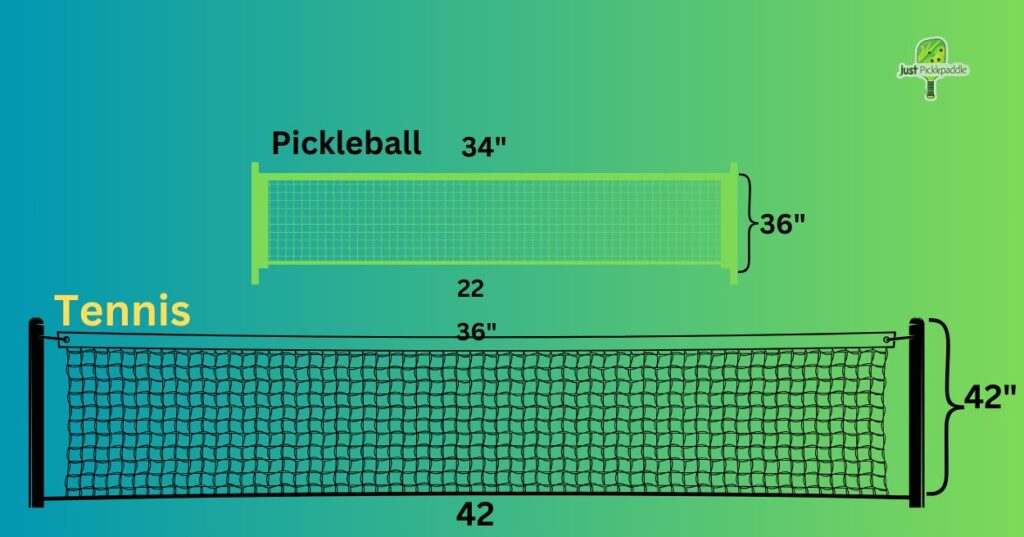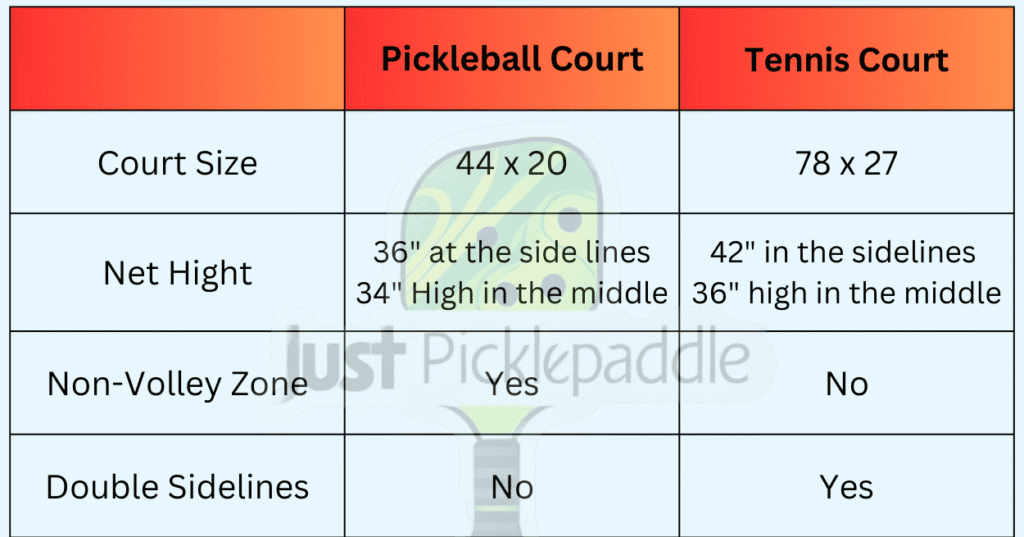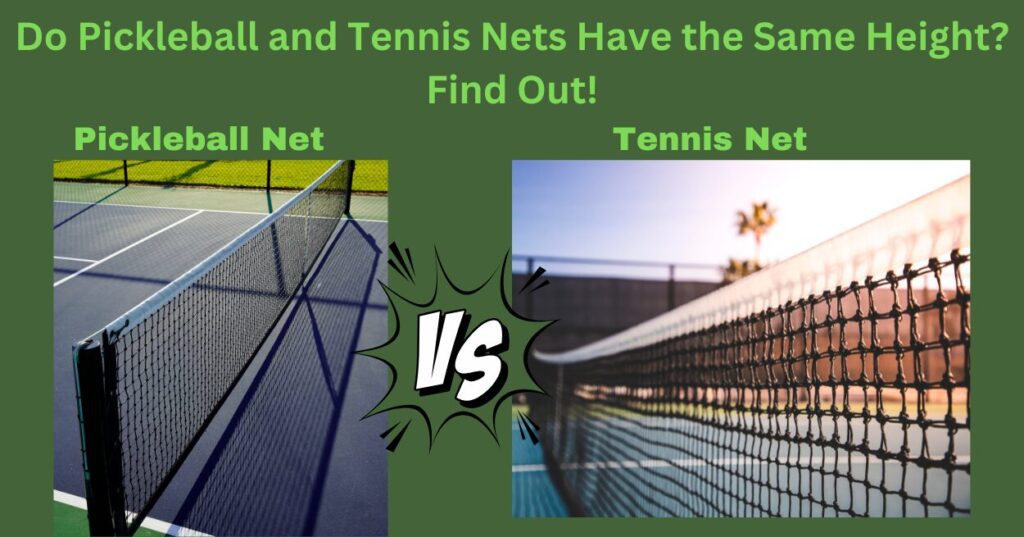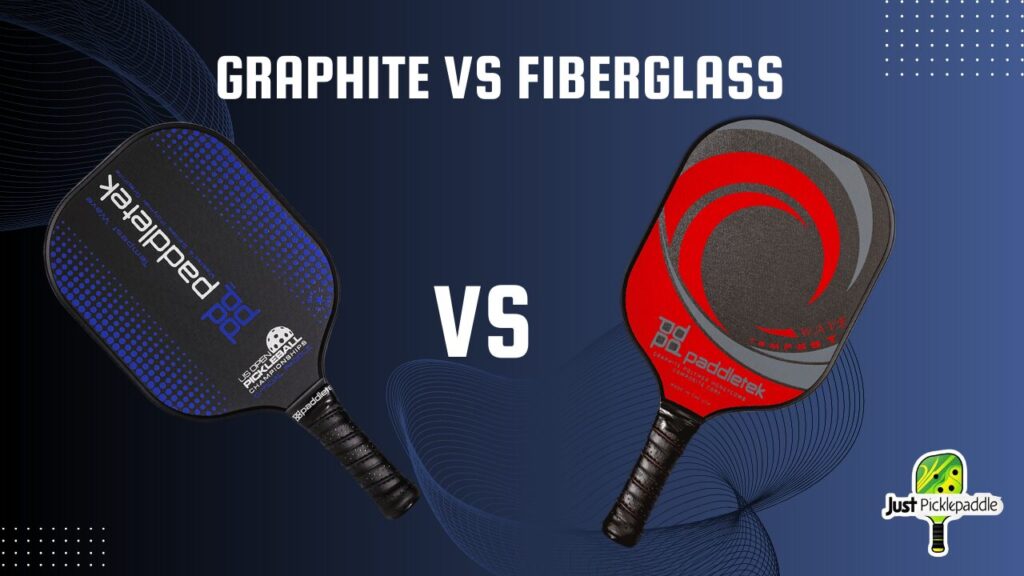In the world of sports, especially for those who love pickleball and tennis, the question often arises: Are the nets in these two games the same height? Both games are incredibly popular, with pickleball rapidly gaining popularity recently. As a result, many newcomers and enthusiasts wonder if they share similarities, particularly regarding their net heights. While the games may seem exciting and similar in their fast-paced gameplay, they are distinct regarding dimensions and rules.
The tennis net stands at high positions: 42 inches on the sidelines and 36 inches on the center. Meanwhile, a pickleball net is slightly lower, standing at 36 inches on the sidelines and 34 inches in the center. These distinct heights are just one example of how the two sports differ in their properties. However, modifying a tennis net to accommodate pickleball players has become a practical workaround for those playing on a temporary or shared court. This can sometimes be an obstacle if proper adjustments aren’t made.
Understanding the differences and similarities between pickleball and tennis nets is crucial for players of all ages and skill levels. By knowing these dimensions, players can make the most of their equipment and ensure a fair game, regardless of whether they are playing on a dedicated court or temporarily modifying their setup. This knowledge can eliminate confusion and ensure that both sports continue to thrive, offering excellent opportunities for players worldwide.
Table of Contents
Understanding Pickleball and Tennis
Understanding pickleball and tennis starts with the net height and dimensions—key basics that differentiate the two sports. Take a moment to dive into the specifics and understand how these elements shape the game.
Pickleball: The New Paddle Sport
Pickleball is an exciting paddle sport that combines the elements of tennis, badminton, and ping-pong, creating a unique blend of fun and competition. It is played on a one-fourth the size of a full-sized tennis court, measuring 20 feet by 44 feet. This makes it ideal for players who enjoy the action but prefer less space.
The sport uses a ping-pong paddle and a plastic ball. Its intense rallies and fast-paced close-quarter play keep players on their toes. One of the defining features of pickleball is the non-volley zone (also known as the kitchen), which extends 7 feet from the net and limits players from stepping into it to hit volleys. This zone adds an extra layer of challenge and strategy to the game.
The sport offers a perfect balance of agility and technique, requiring players to master various skills and strategies similar to racket sports like tennis. Whether playing doubles or singles, pickleball provides an exciting alternative for anyone seeking a dynamic game without needing a full-sized tennis court.
This combination of ping-pong and tennis makes it a growing favorite among people of all ages and skill levels. It offers a fun, social, and competitive experience for everyone.
Tennis: A Timeless Racket Sport
Tennis is a widely recognized and thrilling racket sport that has been played for centuries. It is typically played on a larger court, measuring 78 feet by 27 feet for singles matches and 36 feet for doubles matches. This provides ample space for players to showcase their skills.
The net runs through the center, dividing the court into two halves, and each player or team must send the ball into the opponent’s court within the boundaries. This requires a delicate combination of power, agility, and precision with the racket, making each match physically demanding and mentally engaging.
In singles, players must rely on their skills and stamina. They often run across the larger court size while focusing on strategic positioning to outmaneuver their opponent. The game emphasizes teamwork and communication in doubles, as players work together to cover the court and coordinate their attacks.
Whether played competitively or recreationally, tennis combines the best aspects of athleticism and strategy. It offers a thrilling experience for those who appreciate the game’s rich history and dynamic challenges.
Are Pickleball and Tennis Nets the Same?
The net heights in pickleball and tennis are not the same, and this is an essential distinction for players of both sports. According to the USA Pickleball Association, the standard height for a pickleball net is 36 inches at the center and 34 inches at the sides. In contrast, tennis nets are typically 36 inches at the center and 42 inches at the sides.
| Pickleball Nets | Tennis Nets |
| 36 inches high at posts | 42 inches high at posts |
| 34 inches high in the center | 36 inches high in the center |
| 22 feet wide (post to post) | 42 feet wide (post to post) |
This discrepancy in net height is one of the significant differences between the two sports. It impacts how the ball behaves and how players adjust their shots. The tennis net is higher, allowing the ball to bounce differently than in pickleball, where the net is lower. The plastic ball bounces slightly differently in tennis, affecting performance and muscle memory.
In addition to the height difference, pickleball courts are more minor than tennis courts, measuring 20 feet by 44 feet compared to the larger 42 feet by 27 feet tennis court for singles. This size difference and the lower net in pickleball create a distinct playing environment where players must adjust their strategy.
The lower net allows for a more dynamic and agile game, while the higher net in tennis emphasizes longer rallies and strategic shot placement. Understanding these dimensions is crucial for players to perform optimally in each sport and avoid confusion when practicing or adjusting their game for different match types.
Height Dimensions of Pickleball and Tennis Nets
When it comes to sports, understanding the height dimensions of pickleball and tennis nets is crucial for proper gameplay. While both nets serve similar purposes, let’s delve into the specifics of their differing height dimensions.

Pickleball Net Height
The official rules define the Pickleball net as 34 inches at the center, providing a consistent height for all players. The net must be appropriately positioned and mounted securely to avoid undesired movement or sag, ensuring a fair playing surface. Maintaining the correct height is crucial for fair gameplay, offering players an equal opportunity to hit shots.
If the net is too high, it can pose a challenge and disrupt the level playing field. Adjustable nets are ideal for maintaining proper tension and preventing the net from sagging. A precise, secure mounting ensures no unwanted movement, keeping the game fair and enjoyable for everyone.
Tennis Net Height
The International Tennis Federation (ITF) rules dictate that the height of a tennis net is slightly higher than that of a pickleball net. The net should be 3 feet or 36 inches at the center and somewhat higher towards the sides to create a tight barrier that helps prevent the ball from passing through.
This design provides the proper flexibility to absorb the impact of fastballs while maintaining enough tightness to keep the net in place. Whether for singles or doubles matches, the essential goal is to ensure that the net’s tightness does not hinder the game’s flow, allowing players to hit shots with power and precision.
The balance between maintaining proper tension and providing extra flexibility is key to ensuring the ball remains in play, and the game continues smoothly.
Pickleball Net Width vs. Tennis Net Width
There is a significant difference between the net widths of pickleball and tennis. A pickleball net measures 22 feet and extends across the sideline of a pickleball court. This is much smaller than the 42 feet required for a tennis net, which covers the width of a tennis court.
The difference is even more noticeable in doubles matches, where tennis nets span 42 feet while pickleball nets are 22 feet. The tennis net width for singles is 33 feet, nearly twice the size of a pickleball net. This big difference in net size affects the dynamics of each sport, with tennis requiring a wider net due to its larger court and more expansive gameplay.
Can You Play Pickleball on a Tennis Net?
Playing pickleball on a tennis net is technically possible, but it’s not ideal due to the height difference. A pickleball net should be 34 inches high at the center, while a tennis net is 36 inches at the center, which can result in a higher bounce for the ball. This inconsistency can cause frustrations in gameplay, making it difficult to adapt and hit shots with the correct timing.
While this setup may work as a temporary fix or for casual play, it won’t offer an authentic experience. To make a pickleball network on a tennis court, you’d need to make adjustments, like lowering the center strap or using notches on the side posts to bring the height to the correct 34 inches.
If you’re looking to play pickleball on a tennis court, portable and inexpensive options, such as roll-away nets, are easy to set up and adjust. Public spaces like parks often have tennis courts that can be converted into pickleball courts with simple tools, such as chalk and a measuring tape to mark the standard dimensions.
Pickleball nets can be installed and lowered to the correct height for a more permanent solution, allowing for an enjoyable and authentic experience.
How Does the Dip At The Center of the Net Affect Each Sport?
The dip at the center of the net plays a significant role in both pickleball and tennis, but how it influences the game differs due to the lower net height in pickleball. In tennis, the net posts are higher, creating a lower center that helps maintain neutral rallies and forces players to work harder with their crosscourt and down-the-line shots.
This dip makes hitting the ball over the net a strategic decision, influencing the flow of points. The dip ensures that neutral rallies are maintained and players are challenged to place the ball effectively between players to keep the game moving.
The center dip is even more crucial in pickleball, particularly for strategies like the crosscourt dink and kitchen area control. Pickleball’s lower net height—36 inches—makes it easier to neutralize a rally or force a defensive position. The dip also adds an element of strategy, influencing where and how players place their shots.
This essential element contributes to the game’s fun and strategy. A fun fact is that the original pickleball net height was 60 inches, influenced by the badminton net height. Over time, it was lowered to 36 inches to match the sport’s dynamics better.
How Does the Net Height Impact Gameplay?
The net height has a crucial impact on how pickleball and tennis are played, influencing the trajectory, bounce, and overall pace of the game. In pickleball, with its smaller, lower net, the ball tends to have a lower bounce and is affected more by air resistance. The standard height for a pickleball net is 36 inches, which makes it easier to generate controlled shots that don’t travel as fast or high.
The lower net height helps maintain an attainable pace for players at all skill levels, but it also makes it challenging to clear the net when the ball is hit too high. Conversely, tennis uses a higher net at 42 inches, requiring a greater skill level to keep the ball within bounds. A standard tennis ball, being heavier and without holes, is less affected by air resistance, allowing it to travel faster and generate a higher bounce.
The net itself adds complexity to the gameplay by determining the bounce and distance the ball can travel. In tennis, a higher net often makes it more difficult for the ball to travel fast or clear the net quickly, especially when it is hit with power.
Conversely, the lower net in pickleball allows the ball to travel more efficiently and bounce higher, making the game more about precision. The regulatory body for each sport governs these net heights, ensuring they are consistent across matches and fair play. The net height directly influences the ball’s behavior, affecting everything from bounce to shot placement.
Difference Between Pickleball vs Tennis
Key Differences in Net Heights
Pickleball Net Height:
- The net height is 34 inches at the center.
- This fixed height creates a controlled pace of play, favoring precision.
Tennis Net Height:
- The net height is 36 inches at the center.
- A higher net contributes to faster and more dynamic gameplay.
Influence of Court Surface:
- The higher tennis net can slow down the game on grass courts due to a softer surface.
- On hard courts, the lower pickleball net complements the faster pace of play.
Effect on Gameplay:
- Tennis tends to have a faster pace, influenced by the higher net and ball speed.
- Pickleball has a slower pace, with the lower net helping compensate for the softer movement of the ball.
These differences in net heights and court surfaces shape the style and flow of the two sports, making each one distinct in how the game is played.
Court Size Difference
Pickleball Court Dimensions
Pickleball courts are more minor than tennis courts. The standard dimensions for a pickleball court are 20 feet wide by 44 feet long. For singles matches, the court size remains 20 feet by 44 feet, providing a compact playing area that influences the game’s dynamics.

Tennis Court Dimensions
In contrast, tennis courts are much larger, with 27 feet wide and 78 feet long standard dimensions. The larger court size directly influences gameplay, offering more space for players to move around and making the game faster and more expansive.
Impact on Net Height and Gameplay
The lower net height in pickleball is ideal for the smaller court size, allowing players to clear shots comfortably without as much challenge. On the other hand, the higher net height in tennis works better for the larger court size, creating an appropriate level of challenge for players and making the game more dynamic.
Variation in Net Height
The net height plays a crucial role in how each game is played. The lower net is ideal for the smaller court in pickleball, offering more control over shots. In tennis, the higher net adds difficulty and complexity, fitting the larger court and enhancing the overall challenge of the sport.
These significant differences in court sizes are crucial in determining how both sports are played, shaping the optimal playing environment for players in each game.
Skill and Gameplay Variation
Pickleball and tennis differ significantly in terms of gameplay and skill requirements. Due to its lower net height and slower pace, pickleball is often seen as a more accessible sport, particularly for beginners and older adults.
The smaller court size and easier shots make it a more forgiving sport, allowing players to get into the game without needing to be physically demanding. The lower net height helps keep the gameplay more manageable, with less emphasis on power and more focus on strategic placement and control.
In contrast, tennis is a more physically demanding sport, requiring greater agility, power, and precision. The higher net height creates a more challenging playing field, demanding players to use more athleticism and accuracy to place shots effectively. Tennis requires greater physical exertion and shot placement, making it a competitive and demanding experience.
The sport’s reliance on power and agility adds complexity, making it a more significant challenge for players of all skill levels, especially those trying to master high shots over a higher net. Net height and court dynamics variables influence the skill levels needed to succeed in each sport.
5 Essential Tips to Maintain Your Pickleball & Tennis Nets
Properly maintaining your pickleball and tennis nets not only ensures peak performance but also helps save money in the long run by avoiding the need for frequent replacements. Below are five essential tips for keeping your nets in excellent condition:
| Tip | Description |
| 1. Regular Inspections | Check your nets regularly for rips, holes, or other signs of wear and tear. This will help you catch issues early. |
| 2. Immediate Repairs | If you spot any damage, repair it immediately to prevent the problem from worsening. |
| 3. Routine Cleaning | Clean your nets with mild soap and water to remove dirt, debris, and weather residue that could damage the fabric. |
| 4. Proper Storage | Store your nets in a cool, dry place to protect them from harsh weather conditions when not in use. |
| 5. Timely Replacement | Replace your nets every few years to ensure they remain in top condition and perform at their best. |
Final Thought
While both pickleball and tennis are engaging and popular sports, their net heights significantly influence the dynamics of each game. Pickleball nets are slightly lower at the center and sides than tennis nets, which promotes a more agile and precise style. Conversely, tennis benefits from a higher net that challenges players with longer rallies and more powerful shots.
Understanding these distinctions, along with the unique characteristics of each sport, helps players maximize their equipment and adjust to each game’s style and pace. Whether playing on a shared or dedicated court, this knowledge ensures an enjoyable, fair, and strategic experience for players of all levels.
Can you use tennis court nets for pickleball?
The easiest solution is to lower the tennis net to 34″ at the center. You can tape or paint lines on the court for pickleball (be sure to get approval from the facility beforehand). This setup allows the court to seamlessly accommodate both tennis and pickleball.
Can you turn a tennis court into a pickleball court?
Since a tennis court measures 60′ wide and 120′ long, there’s plenty of room to mark out a pickleball court. With a standard pickleball court measuring 20′ wide and 44′ long, you can even fit up to four pickleball courts on a single tennis court.
Is pickleball easier than tennis?
Yes, pickleball is typically easier to learn because of its smaller court size, straightforward rules, and slower pace. Beginners can grasp the fundamentals quickly, whereas tennis demands more time to develop skills like serving, footwork, and technique.




zvhye7
I do agree with all of the ideas you’ve presented in your post. They are very convincing and will certainly work. Still, the posts are very short for newbies. Could you please extend them a bit from next time? Thanks for the post.
Yes i will do my best to extend more.
I believe this website holds some rattling excellent information for everyone :D. “A friend might well be reckoned the masterpiece of nature.” by Ralph Waldo Emerson.
Thank you, I’ve recently been searching for information about this topic for ages and yours is the greatest I’ve discovered till now. But, what about the conclusion? Are you sure about the source?
yeah I am sure
I’m impressed, I have to say. Really rarely do I encounter a blog that’s each educative and entertaining, and let me tell you, you have hit the nail on the head. Your idea is outstanding; the issue is something that not enough individuals are talking intelligently about. I am very happy that I stumbled throughout this in my seek for one thing referring to this.
I must show some appreciation to you just for bailing me out of such a situation. Because of looking out throughout the the web and finding thoughts that were not powerful, I thought my life was done. Existing devoid of the answers to the problems you have fixed all through this website is a critical case, as well as the kind which might have badly affected my entire career if I had not come across your blog post. The mastery and kindness in taking care of everything was priceless. I don’t know what I would’ve done if I hadn’t come across such a stuff like this. It’s possible to now look ahead to my future. Thank you so much for this reliable and effective help. I will not think twice to suggest your web sites to anyone who will need guidelines about this problem.
I love your blog.. very nice colors & theme. Did you make this website yourself or did you hire someone to do it for you? Plz reply as I’m looking to construct my own blog and would like to find out where u got this from. thanks a lot
I regard something genuinely special in this web site.
It’s really a nice and useful piece of info. I am glad that you shared this helpful information with us. Please keep us informed like this. Thank you for sharing.
I’m still learning from you, while I’m trying to achieve my goals. I certainly enjoy reading everything that is posted on your website.Keep the information coming. I liked it!
Thank you a bunch for sharing this with all folks you actually recognize what you’re talking approximately! Bookmarked. Kindly additionally consult with my web site =). We could have a link alternate arrangement among us!
Heya! I’m at work surfing around your blog from my new iphone 4! Just wanted to say I love reading through your blog and look forward to all your posts! Carry on the excellent work!
Keep functioning ,remarkable job!